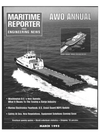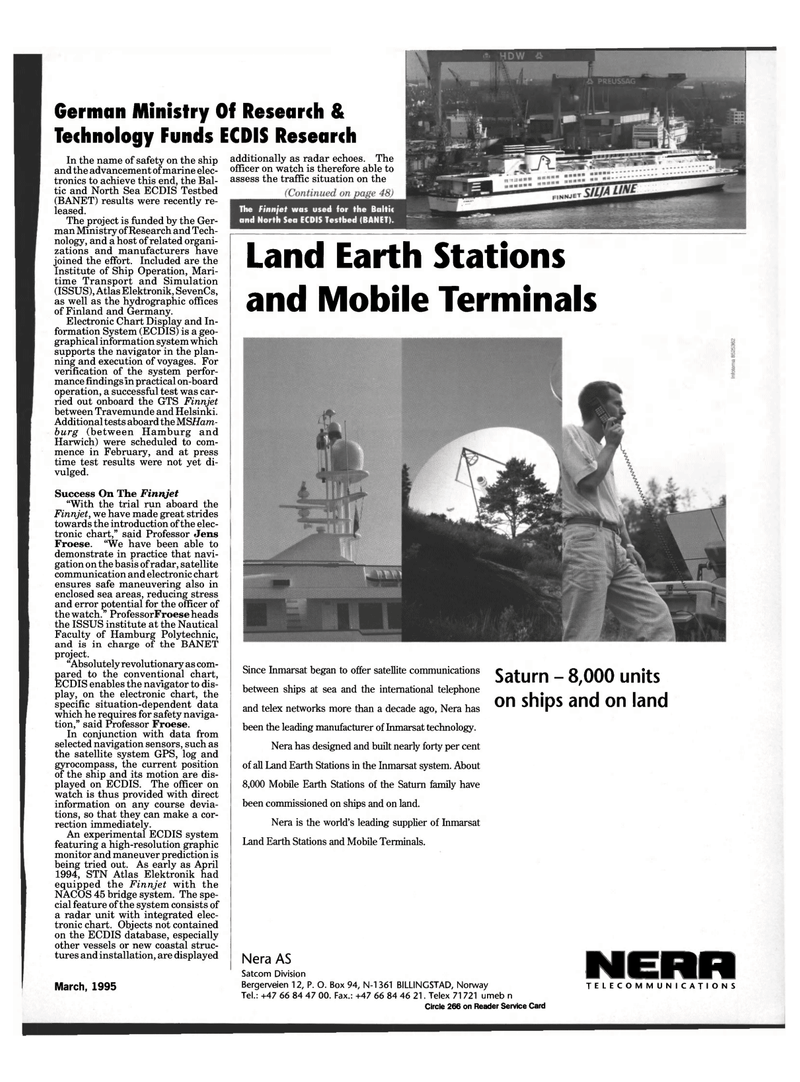
Page 45: of Maritime Reporter Magazine (March 1995)
Read this page in Pdf, Flash or Html5 edition of March 1995 Maritime Reporter Magazine
March, 1995 Bergerveien 12, P. O. Box 94, N-1 361 BILLINGSTAD, Norway TELECOMMUNICATIONS
Tel.: +47 66 84 47 00. Fax.: +47 66 84 46 21. Telex 71 721 umeb n
Circle 266 on Reader Service Card
German Ministry Of Research &
Technology Funds ECDIS Research
In the name of safety on the ship and the advancement of marine elec- tronics to achieve this end, the Bal- tic and North Sea ECDIS Testbed (BANET) results were recently re- leased.
The project is funded by the Ger- man Ministry of Research and Tech- nology, and a host of related organi- zations and manufacturers have joined the effort. Included are the
Institute of Ship Operation, Mari- time Transport and Simulation (ISSUS), Atlas Elektronik, SevenCs, as well as the hydrographic offices of Finland and Germany.
Electronic Chart Display and In- formation System (ECDIS) is a geo- graphical information system which supports the navigator in the plan- ning and execution of voyages. For verification of the system perfor- mance findings in practical on-board operation, a successful test was car- ried out onboard the GTS Finnjet between Travemunde and Helsinki.
Additional tests aboard the MSHam- burg (between Hamburg and
Harwich) were scheduled to com- mence in February, and at press time test results were not yet di- vulged.
Success On The Finnjet "With the trial run aboard the
Finnjet, we have made great strides towards the introduction of the elec- tronic chart," said Professor Jens
Froese. "We have been able to demonstrate in practice that navi- gation on the basis of radar, satellite communication and electronic chart ensures safe maneuvering also in enclosed sea areas, reducing stress and error potential for the officer of the watch." ProfessorFroese heads the ISSUS institute at the Nautical
Faculty of Hamburg Polytechnic, and is in charge of the BANET project. "Absolutely revolutionary as com- pared to the conventional chart,
ECDIS enables the navigator to dis- play, on the electronic chart, the specific situation-dependent data which he requires for safety naviga- tion," said Professor Froese.
In conjunction with data from selected navigation sensors, such as the satellite system GPS, log and gyrocompass, the current position of the ship and its motion are dis- played on ECDIS. The officer on watch is thus provided with direct information on any course devia- tions, so that they can make a cor- rection immediately.
An experimental ECDIS system featuring a high-resolution graphic monitor and maneuver prediction is being tried out. As early as April 1994, STN Atlas Elektronik had equipped the Finnjet with the
NACOS 45 bridge system. The spe- cial feature of the system consists of a radar unit with integrated elec- tronic chart. Objects not contained on the ECDIS database, especially other vessels or new coastal struc- tures and installation, are displayed
Since Inmarsat began to offer satellite communications between ships at sea and the international telephone and telex networks more than a decade ago, Nera has been the leading manufacturer of Inmarsat technology.
Nera has designed and built nearly forty per cent of all Land Earth Stations in the Inmarsat system. About 8,000 Mobile Earth Stations of the Saturn family have been commissioned on ships and on land.
Nera is the world's leading supplier of Inmarsat
Land Earth Stations and Mobile Terminals.
Saturn - 8,000 units on ships and on land
Nera AS
Satcom Division NERR additionally as radar echoes. The officer on watch is therefore able to assess the traffic situation on the
Land Earth Stations and Mobile Terminals

 44
44

 46
46
